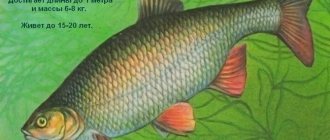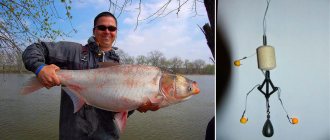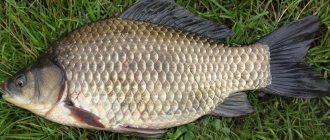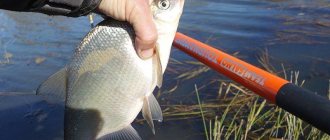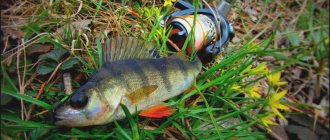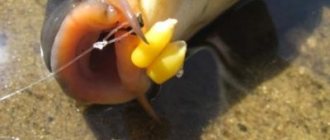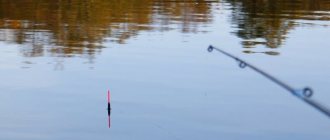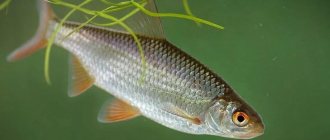Catching chub in the fall is no less exciting than catching this cautious and strong fish in the summer. The autumn months are abundant in catches of trophy chub, fattened during the previous months of warm water, and it is worth mastering the hunting technology in this period of the year, even based on this feature. Fishing for chub in the autumn requires special approaches to tactics, because the fish almost no longer feeds on insects, which became much smaller in September, and in the following months they completely disappear from the fish’s diet, and switches to a different diet, which is caught in the depths water and at the bottom.
Consequently, spectacular fly fishing and an ordinary float will not bring significant catches, and the fisherman has to use ingenuity and knowledge that contribute to the successful outcome of chub fishing. But if ingenuity is a purely individual matter, inherent in each angler individually, then knowledge can be obtained from the article presented below, which will help you understand the formation of equipment for chub in the fall and the development of the fishing strategy itself.
How does the autumn chub behave?
From the end of August, the behavior of chubs begins to change radically, and these changes are associated with the cooling of the water and a change in diet. Of course, you can still catch chub in the upper layers of water in September, but much less often than on summer days. Now the fish moves to deep-water sections of rivers, where it descends to levels of 4–6 meters and looks for fry and other small aquatic inhabitants for prey. The insects that departed with the advent of cold weather no longer satisfy the predator’s appetite, which is beginning to grow in winter, and it has to hunt for small fish, rising to the surface only on rare warm and sunny days. In late autumn, the chub finally moves to the edges of the wintering pits and loses its former activity and is now very rarely caught until significant warming occurs after the ice melts.
Choosing a fishing spot
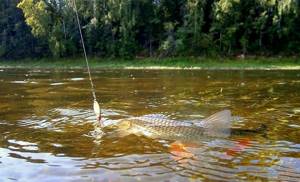
With the transition to deep feeding, chubs leave areas with moderate and fast currents, looking for calmer places to stop at the contacts of the main channel jets with the slower flows of backwaters and areas slowed down by the rubble of fallen trees, hydrological and reclamation objects. Even on small rivers, the fish stay near the cool water in quiet pools and in places shaded by the crowns of trees and bushes hanging over the water. To feed, chubs go to the boundaries of mixing water flows of different speeds, tracking down juvenile fish caught in the stream, frogs and leeches and water beetles picked from algae. It is precisely this kind of crossings in rivers that are considered promising for chub hunting . The fisherman can only provide his camouflage and choose a convenient point on the river bank for casting gear and landing the caught fish.
Important! Chub are sensitive to the fall of shadows on the surface of the water and show wariness from such actions of the fisherman, even at considerable depth, moving away from the fishing grounds.
Therefore, casting equipment from behind natural shelters, ensuring the fisherman’s invisibility and accuracy in moving along the coastline in the fishing area, helps to increase the effectiveness of each chub fishing.
About the chub
The chub is a fish of the carp family, quite large, its dimensions reach about 80 cm in length and weight 8 kg, but usually fishermen come across a chub no larger than 1 kg. The lifespan of this fish is on average 15-18 years. It lives mainly in small, clean rivers with cold water and fast currents, where there are riffles and a rocky and pebble bottom. A very cautious and timid fish. It lives mainly in the rivers of central Russia.
Some people catch chub with a spinning rod, while others prefer to catch them with a float tackle. Catching chub with a float is in no way inferior to catching it with a spinning rod. There are fishermen who only like float tackle, so this article will discuss exactly how to catch chub with a float rod.
Chub fishing in September

September is famous for its excellent chub bite. The fish fatten, actively feeding, collecting food in the surface layers of the reservoir. Chub fishing continues with fly fishing and float rods both from the surface and in the water column. The fish still hang on to the currents near trees hanging over the water and steep banks. The main component of its diet remains insects that fall on the water. A reduced amount of food causes increased competition between populations of chubs starting to flock together, which further stimulates biting. The fish is aggressive and any movement on the water where the predator is staying is accompanied by an instant attack from the depths.
Important! The best time for fishing is sunrise and before 10 am. In the evening hours, chubs bite until sunset.
Sunny and calm weather with high atmospheric pressure activates the bite. Rain and cold weather reduce the feeding activity of the predator.
Feeders for catching chub in autumn
Feeders for catching chub are divided into open and closed. The open feeder is a spring on a lead rod. At the same time, it can slide along the fishing line, or be motionless. If you need to deliver bait instantly to a fast current, then it is better to use large frame feeders.
In fishing stores there is a special ready-made bait for chub. But if there is no suitable option, then you can buy mixtures for roach or bream.
Closed feeders look like a pencil box with holes in it. Food is placed inside, mainly from live ingredients:
- bloodworm;
- maggot.
The weight for the feeders is selected according to:
- with the speed of the current where fishing occurs;
- with the casting range of the feeder.
Chub fishing in October
With the arrival of October, and sometimes already in September when weather conditions worsen and the air temperature drops below 10–12 degrees, chubs go into the water column and switch to feeding on fry. There are no easily accessible mayflies anymore and the fish are forced to gain calories by hunting for small bleak in the middle water horizons and for minnows at the bottom. Float fishing and fly fishing become ineffective with this behavior of fish and anglers switch to bottom fishing and fishing in promising places with spinning baits.
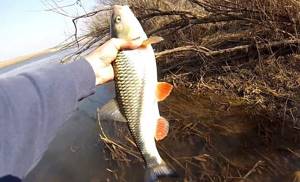
Important! They no longer look for fish on currents, but rather look for water areas where fast and slow water mixes, fishing the areas of the reservoir bordering these territories.
Feed is increasingly being used to attract fish to bottom fishing spots. The chub bites on the donka throughout the daylight hours. October days for fishing are best selected in clear sunny weather with low wind force.
Features of fishing by month
At the beginning and end of autumn, the behavior of the chub changes as the temperature drops. Fishing for it in September is different from fishing in November. Fish, depending on the weather, choose different places to feed. If the river is covered with ice too early in November, then it is already useless to catch chub.
September
On warm September days, chub can bite well throughout the day, but the best bite will be observed in the morning and evening . But even in warm September, the nights are already cold and the water is cooling, so you should go fishing when it warms up, i.e. no earlier than 10 o’clock in the morning.
When it is a warm and sunny day, chub can be found in sections of the river with protruding relief (spits, ridges). In such weather, it will also swim to the shore under trees and bushes or be in snags. During this period, this fish can go to shallow water and to places with variable currents: to the mouths of streams, to riffles and backwaters. These fish can also search for food at different depths at the boundaries of fast and quiet water. On small rivers, a good fishing option is to cast a fishing rod from cliffs overgrown with bushes. It wouldn't hurt to pay attention to snags and holes.
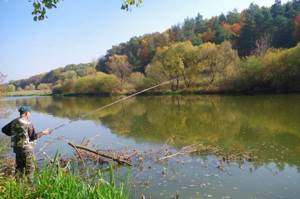
October
From October the cold weather becomes more stable and chub can be found mainly on the bottom. Bottom gear is usually used this month. Often fish swim to shores with overhanging vegetation in order to make money. In October, you should go out to catch chub closer to noon, since the river should already have warmed up by this time. On a warm sunny day, this species can still be found in the middle waters of the river, but in cloudy weather the fish will sink to the bottom. At this time, the chub prefers to be only in a calm current. It is good to use a small-sized spoon (no more than number 2) as bait.
You will be interested to learn about the features of chub fishing in winter.
November
At the end of autumn, the chub goes deeper, but in the afternoon it can still be active. Fishermen noticed that before the first ice appears on the river, this fish begins to consume food especially actively before the hungry winter and begins to actively peck. At this time, it can be easily caught, and it is important not to miss this period.
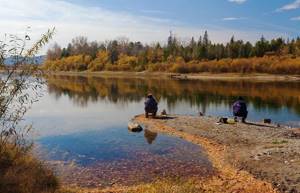
You should go fishing in the afternoon, when the water is warmest. Chub are rarely found off the coast, so when fishing offshore, the fish are first fed. During this period, the chub reacts well to jig baits. Their size should be no more than 4 cm. In autumn, the water acquires extraordinary transparency and purity, so it is better to take baits of natural colors, but if your area has muddy water, then it is better to choose a brighter color so that the fish will definitely notice it.
Important! Don't forget to take a landing net with you when fishing. It will be a shame if at the last moment a large fish falls off the hook. And the chub is known for its desperate resistance.
Autumn is quite suitable for chub fishing. For this, you should choose fine days and go fishing after the water warms up.
Chub fishing in November
In November, the intensity of the bite subsides. Cold water finally places the fish in winter resting places in the depths of holes, underwater ditches and ravines. The migration of flocks gathered for wintering stops and only a few individuals come out to feed on the edges of the depressions, eating the gape fry. The most effective tackle for catching chub in the fall in November is a donka mounted on a feeder or spinning rod.
Important! You can count on a stable bite only as a result of sharp November warming, accompanied by an increase in temperature over 10 degrees, stabilization of atmospheric pressure and clear sunny weather.
On such days, chubs begin to become active around lunchtime and until dusk.
What to use to catch chub in the fall
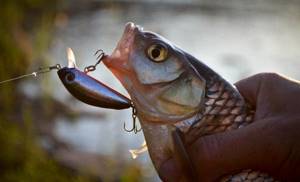
Bait for chub in the fall can be of artificial or animal origin. Plant baits can only work in early September, when weather conditions are similar to summer and the water temperature is 16 degrees or higher. At the beginning of autumn, chubs are caught from the surface and upper horizons of the water using artificial flies of dry and wet types. Spinning fishing involves the use of rotating spinners and small crank-type wobblers, with a factory low-frequency action. Fishing with float tackle is carried out for maggots, bloodworms and small dung worms. Good results are obtained by combining these attachments in various variations. Among the animal baits used in bottom fishing, bleak, verkhovka and gudgeon fry are used.
Important! Large specimens are effectively attracted by a frog mounted on a hook.
Also, the bottom fishing rod can be equipped with a leech attachment, crayfish meat and grape snail. Recently, fishermen have widely used pieces of boiled sausage as inert bait. The cutting is done in the form of a cube with sides up to 1 cm, mounted on large hooks 4–6 numbers. The smell and color of this bait attracts chubs and brings significant results in fishing.
Bait for autumn fishing
Despite the fact that the chub is a peaceful fish species, large individuals do not disdain animal food in the fall. The victims of maple are fry, leeches, frogs, snails and bivalves. In each specific river or area, the chub has its own food preferences.
- For example, in the southern regions of the country there are many grape snails, which end up in the reservoir after rains. In other rivers, fish feed on lamprey larvae in the fall. For this reason, it is necessary to find out the diet of the local chub and prepare tasty bait.
- Don't discount plant baits either. Steamed peas and canned corn are perfect for hunting trophy fish. In some areas, maple likes boiled wheat, pearl barley, or pieces of bread.
- Fishermen from the southern regions talk about a good chub bite on exotic baits such as cherries or cucumbers. I am quite skeptical about such baits and doubt the possibility of purposefully catching maple with exotic ones.
Lure
Especially often when feeder fishing, bait is used to stimulate the fish to approach the casting points of the rigs. Chub baits do not differ in the specificity of their recipes and often consist of adding one animal component to the feeders. For these types of baits, closed feeders with a small mesh are used, which prevents the simultaneous release of food out, and supplies it to the fishing zone gradually and in small quantities. The food used is maggots and bloodworms.
Important! The bait must move, and only this feature can arouse the interest of the chub.
Some fishermen load feeders with mashed black bread soaked in fish oil, adding to it small dung worms torn into pieces, which will continue to move for some time, bloodworms and maggots. For such compositions, feeders with a larger cell are used, allowing the bread to be washed out more intensively and create cloudy, odorous oil stains, collecting predators from large areas of nearby water areas.
How to catch chub in autumn
The autumn season is divided into two periods, in one of which chubs are caught purely in surface waters and the second, when they switch to catching predators at the bottom. The first period is short-term and, as a rule, lasts only until the third ten days of September. The second half of autumn fishing is carried out using bottom gear, which helps catch fish that have descended to the depths from the bottom. Continuing the article, we will consider the three most popular ways of catching chub in the fall - spinning, fly fishing and using bottom gear.
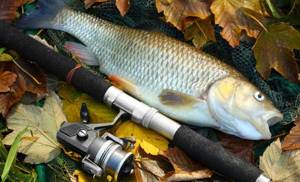
Donka
In chub hunting, several methods of bottom rigs are used, which are mounted on rods using reels. The simplest way is to make a zakidushka. The cast is formed on a rigid spinning rod using an inertia-free reel equipped with a braided cord with a diameter of 0.12 mm. The installation of the casting itself consists of a flat sliding sinker, the stroke of which, no more than 50–70 cm, is limited by silicone stoppers, and the mass is selected based on the current forces at the place where the equipment is cast. A leash made of monofilament fishing line 0.12-0.15 mm long, 25–40 cm long, equipped with a single hook for fishing with live bait with an elongated fore-end, is mounted behind the sinker.
Feeder gear is assembled using a similar algorithm, only instead of weights, a feeder with a cell for the type of complementary food used is used. The length of the feeder gear rarely exceeds 3 meters. Donks are equipped with bite alarms, and since fishing is carried out exclusively during daylight hours, the simplest and most practical is a bell or bell, mounted using a clamp on a quivertip rod.
Important! Bottom tackle is thrown onto the edges of holes near the predator’s parking areas, selecting water areas of the reservoir at a mixture of currents of different strengths.
As a rule, fishing is carried out at considerable distances as far as possible from the shore.
Catching chub in the fall with a spinning rod

Chub fishing in the fall using spinning rods is carried out in September and October, when the fish comes out to feed in the surface and middle water horizons. The most effective type of tackle is ultralight, which allows the use of light, low numbers according to the Meps classification of spinner spoons and miniature wobblers.
Important! For spinning hunting, crank-type wobblers are used, which have a bright and distinct play of their own with a narrow stroke.
Inertia-free reels are charged with nylon fishing line up to 0.2 mm in diameter, capable of dampening the jerks of powerful fish when playing. Spinning rods are used to fish currents and areas of calm water adjacent to riverbeds. Using baits with positive buoyancy, the rafting technique is used to fish sections of rivers under tree crowns hanging over the water. To catch chubs, uniform movements against the currents are used without any kind of pauses or accelerations.
Fly fishing
Fly fishing is practical at the very beginning of the fall season, when fish feed on mayflies. Lightweight fly fishing rods 2.5 meters long are suitable for fishing, which are equipped with inertial reels and special cords with floating or sinking end sections of fishing line. Fly fishing flies are used as baits, imitating various types of insects. The fly is placed on the surface of the water in a promising fishing spot and twitched, creating movements similar to the movements of a floundering insect that has fallen into the water. Fishing techniques require special training and practicing fishing techniques. As a rule, chubs are caught with fly fishing in wads in shallow areas of reservoirs with moderate currents over riffles and rocky rapids.
Methods for catching autumn chub
For autumn fishing, several options for catching fish are used. Each method will bring good luck with the right approach. Most often, different types of bottom gear are used for fishing.
- Traditional fishing rods are still relevant for chub fishing. Donka supply is a simple and affordable tackle. It consists of a short rod, a reel, monofilament (0.3-0.45 mm), a heavy flat sinker and 1-3 large hooks (No. 4-8). After casting the rig, the line is tied to a peg driven into the bank. The usual bell becomes a bite alarm.
- A more advanced tackle is a donka with a reel. The set requires a rigid rod (2.1-2.7 m), an inertial or inertia-free reel, a main line 0.3-0.4 mm thick, and a monofilament leash 0.2-0.25. During the fishing process, the rod is placed on a stand, and a bite alarm is attached to the tip of the shaft.
- If a donk with a reel is equipped with a feeder, you will get an even more catchy fishing design. Depending on the nature of the bait, a closed or open model is selected. For example, porridge-like food requires swinging structures, but when using maggots or bloodworms in bait, it is better to use closed modifications.
- The most advanced bottom tackle today is a feeder or picker. Thanks to the flexible and sensitive tip of such a rod, you can see any touch of the fish on the bait. The presence of several replaceable tips in the set allows you to fish at different depths and current strengths.
Chub biting and fishing
Chubs are distinguished by their special fighting spirit and sharpness. Chub biting and fishing require constant monitoring and concentration on the part of the angler. The fish almost never flirts with the bait, immediately taking the prey and going into the depths towards the current towards the middle of the reservoir. Serifs are not required in most cases. The trophy is detected independently. The crucial stage is fishing, which is best assisted with a reel, after carefully adjusting the clutch.
Drastically forcing the fishing action with the rod will lead to the leader breaking during one of the next fish throws. Feeling strong resistance, the trophy is allowed to move back to the length of the fishing line released as a result of the clutch, and when the speed slows down, they again begin energetically winding the cord with the reel, bringing the predator to the zone where it can be conveniently taken into a pre-prepared landing net.
Bottom fishing with live bait
In autumn, animal components predominate in the diet of large chub. In this regard, one of the traditional types of fishing for the handsome redfin in October is donka with live bait. To assemble the gear you will need:
- spinning rod measuring 2.4-2.7 m with a test load from 40 to 60 g;
- spinning reel with 2500-3000 spool;
- monofilament line 0.20-0.30 mm, length 50-100 m;
- sliding flat sinker weighing 20-40 g;
- metal leash if there is pike in the river;
- single hook No. 2-3.
A bell can act as a bite alarm, and at night it is advisable to supplement it with a firefly.
Various small fish can be used as bait. The chub reacts best to local small things, which may include:
- gudgeon;
- dace;
- loach;
- roach;
- bleak.
Frogs and river lamprey larvae can also be used for live bait fishing.
In October, chub biting on live bait is most often observed in the afternoon and at night. The fisherman needs to take these factors into account and thoroughly prepare for fishing. At night, you should not make noise or light a fire near the shore, as large chub are quite cautious. During the night, the bite is distributed unevenly; the last bursts of fish activity are observed at dawn.
